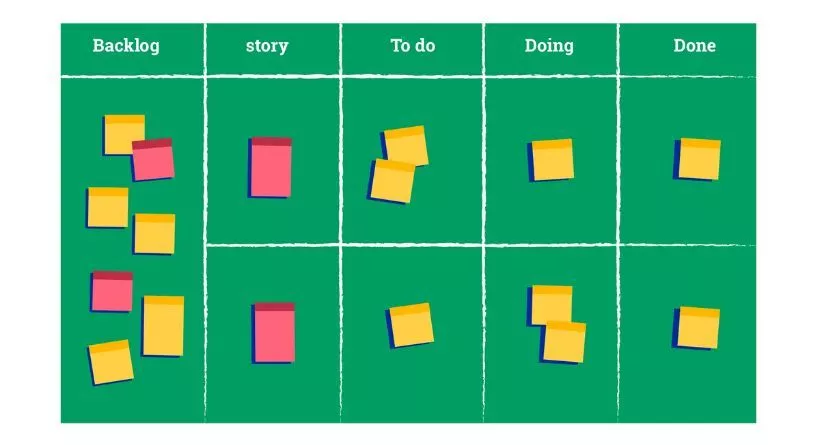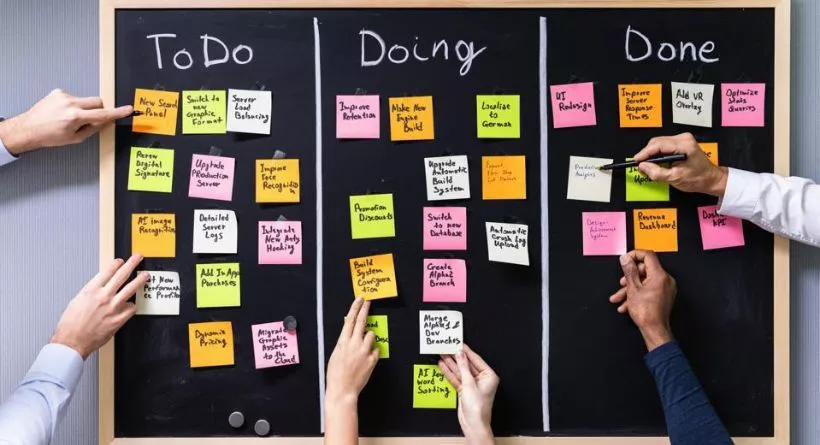You’re a dedicated team member, and like many others, you are faced with a common yet troublesome issue. You’re trying to implement Agile project management into your workflow, but there’s a snag: organizing, visualizing, and keeping track of tasks in a Scrum environment. You’re not alone in this struggle. It’s a problem many encounters when transitioning to Agile methodologies. But don’t worry, this post is about to make your life a lot simpler. We’re here to guide you through the process of creating an effective Scrum Board.
Just think of it, no more worrying about lost sticky notes or untracked progress. Instead, imagine a streamlined and efficient way to keep your entire team on the same page, all the time. That’s the power a well-designed Scrum Board can bring to your team.
Now, allow us to draw your attention to a concept that might alleviate a significant portion of your Agile project management woes: the Scrum Board. It’s an indispensable tool designed to enhance collaboration, improve visibility, and foster transparency within your team. By the end of this post, you’ll know how to create your own Scrum Board to tackle the very problem you’re facing. So, let’s dive in!
What is a Scrum Board?
In your journey through Agile project management, you might have encountered numerous tools and terminologies. One such tool that significantly enhances your workflow is the Scrum Board. But what exactly is a Scrum Board?
Scrum Board Example
There are benefits to using a digital scrum board instead of a physical one. One of the various project views in ProjectManager is a virtual scrum board, which might be useful if your scrum team is collaborating with other teams who don’t use an agile methodology. Additionally, our scrum board may be shared at any time and from anywhere.
Your scrum board is constantly updated in real-time thanks to our cloud-based software, which promotes collaboration and establishes a single source of truth so that everyone is always in the know. Check out the example scrum board below, then sign up for ProjectManager for free right now.
Defining the Scrum Board
A Scrum Board is a visual display. It helps your team track progress and coordinate efforts. It’s a simple, yet incredibly powerful tool that provides an at-a-glance view of the project’s state. Think of it as a mirror, reflecting your team’s work patterns and progress in real-time.
However, the true power of a Scrum Board lies not just in its ability to display information. More importantly, it promotes transparency, boosts collaboration, and accelerates decision-making within your team. Simply put, a well-implemented Scrum Board is like a compass guiding your team towards its Agile goals.
2 Types Of Scrum Boards
Even though the majority of project management tasks are now completed digitally, some employees still like the manual approach.
Only two types of Scrum boards are available for use:
Physical board
Digital Scrum board
Here is a guide to help you decide which one to pick:
Physical Scrum board
Any surface, including a whiteboard or a corkboard, may be used to construct a physical Scrum task board.
Create the customary three columns on your board: “To do,” “WIP,” and “Done.” The sprint’s specific tasks are then listed on sticky notes.
Sticky notes may be moved around to different columns on the task board while your team works on the Scrum job.
B. Online Scrum board
An electronic version of a physical task board is a Scrum board.
Project tasks are represented visually on a digital task card rather than on sticky notes.
That would be like contrasting today’s iPhone with a desk phone from the early 1900s!
Physical Scrum boards are embarrassingly out of date and may even occupy important workplace space.
The Importance of Scrum Board in Agile Project Management
The Scrum Board isn’t just another accessory in your Agile toolkit; it’s a vital component. In the dynamic and fast-paced realm of Agile, where change is constant, a Scrum Board offers much-needed stability and clarity.
It ensures that every team member knows their tasks, the tasks’ status, and what their teammates are working on. In this way, it fosters a sense of shared responsibility and accountability, crucial for successful Agile Project Management.
The Anatomy of a Scrum Board
To leverage the benefits of a Scrum Board, it’s important to understand its structure. Let’s break it down:
Key Components of a Scrum Board
At its core, a Scrum Board is divided into several columns, each representing a stage in your workflow. The most basic Scrum Board includes three columns: “To Do”, “In Progress”, and “Done”.
Tasks, often represented by sticky notes or cards, move across these columns as they progress. Each card carries crucial information such as the task description, assignee, and sometimes, time estimates.
How a Scrum Board Facilitates Workflow
As simple as it may sound, the movement of cards across the Scrum Board is instrumental in facilitating workflow. As a task transitions from one stage to another, it moves to the corresponding column. This provides a visual representation of the task’s journey, thus making progress evident and tangible.
Moreover, it provides a sense of accomplishment for team members as they move tasks into the ‘Done’ column, fostering motivation and productivity. It’s like a pat on the back for every job well done.
In essence, a Scrum Board helps transform your workflow from a vague concept into a visually engaging, tangible process that your team can interact with, understand, and improve upon.
How to Create Your Own Scrum Board
Now that you understand what a Scrum Board is and its importance in Agile Project Management, it’s time to create your own. Remember, there isn’t a one-size-fits-all approach. Your Scrum Board should reflect your team’s unique workflow.
Step-by-Step Guide to Building a Scrum Board

Identify Your Workflow Stages: Start by identifying the key stages of your project. Typically, these include “To Do,” “In Progress,” and “Done.” However, feel free to add other stages specific to your team’s process.
Create Columns for Each Stage: Each identified stage should be a separate column on your Scrum Board. Label each column accordingly.
Populate Your Board with Tasks: Write down each task on a sticky note or card and place them under the “To Do” column. Include crucial details such as the task owner and estimated completion time.
Move Tasks as Progress is Made: As tasks shift stages, move their corresponding cards. This simple action visualizes your project’s progress and fosters a sense of achievement in your team.
Incorporating the Scrum Board into Your Team’s Workflow
The key to successful Scrum Board integration lies in consistent use. The Scrum Board should be a go-to place for updates and meetings. Encourage your team members to interact with it regularly. It’s not just a task tracker; it’s a communication tool.
Scrum Board Best Practices
Adopting a Scrum Board is not the end goal. Maintaining its effectiveness is equally important. Here are a few tips to ensure your Scrum Board remains a vital part of your project management.
Tips for Maintaining an Effective Scrum Board
Keep It Updated: Regularly update your Scrum Board to reflect the true state of your project. An outdated board can mislead your team and hamper progress.
Promote Transparency: Encourage all team members to share their updates via the Scrum Board. Transparency fuels trust and boosts productivity.
Ensure Visibility: Place your Scrum Board where it is easily visible to the whole team. Out of sight can quickly become out of mind.
You may also like reading: Best Freelance Websites to Find Work in 2023
Examples of Effective Scrum Boards
For inspiration, check out Scrum Boards used by leading tech companies like Spotify or Microsoft. These companies have seamlessly integrated Scrum Boards into their workflows, resulting in increased productivity and smoother project management.
Remember, your Scrum Board is not a rigid structure. It should evolve with your project and team. It’s a reflection of your team’s work, a dynamic tool that adapts to serve your unique Agile needs.
Why Your Team Needs a Scrum Board
A Scrum Board is not just a tool; it’s a mindset shift that can profoundly influence how your team collaborates and progresses. Let’s delve into why your team needs this visual facilitator.
Benefits of Using a Scrum Board
A Scrum Board enhances visibility, transparency, and communication, making your team’s workflow more efficient. It ensures everyone is aligned, aware of their tasks, and understands the project’s current status.
A Scrum Board also brings a sense of accomplishment. Seeing tasks move toward the ‘Done’ column can significantly boost your team’s morale and motivation.
Addressing Common Misconceptions about Scrum Boards
There are often misconceptions surrounding the Scrum Board. Some view it as overly simplistic or suitable only for tech or development teams. These are myths.
A Scrum Board is versatile and can be tailored to fit any project or team, tech-based or not. Its simplicity is its strength, allowing for quick understanding and easy adoption.
Transitioning to a Scrum Board
Transitioning to a new tool or methodology often comes with its own set of challenges. Implementing a Scrum Board is no exception.
Overcoming Challenges in Implementing a Scrum Board
The first hurdle you may face is resistance to change. However, remember that introducing a Scrum Board is not about enforcing a new rule but enhancing your team’s efficiency. Encourage open discussions, address concerns, and highlight the benefits to overcome initial resistance.
Secondly, the temptation to revert to old ways can be high, especially when under tight deadlines. It’s crucial to maintain consistency in using your Scrum Board, even in high-pressure situations.
How to Get Your Team Onboard with a Scrum Board
Getting your team onboard starts with clear communication. Explain the ‘why’ behind the Scrum Board – its purpose, benefits, and how it will simplify their work. Incorporate training sessions to ensure everyone is comfortable with the Scrum Board.
Remember, a Scrum Board is more than just a tracking tool. It’s a testament to your team’s progress, a beacon guiding your project to completion. Once fully integrated, it will become an indispensable part of your team’s journey toward successful project execution.
Conclusion
Transitioning to a Scrum Board is more than just implementing a new tool. It’s about fostering a new way of thinking, working, and collaborating. Through this blog, you’ve gained a comprehensive understanding of what a Scrum Board is, how it can streamline your team’s workflow, and the steps to create one. We’ve also debunked some misconceptions and addressed the challenges you might encounter when incorporating them into your team’s routine.
Remember, the beauty of a Scrum Board lies in its flexibility. Tailor it to suit your team’s unique workflow, maintain its efficacy, and let it evolve with your project. The Scrum Board is more than a visualization tool; it’s a roadmap to efficient project management and ultimate success.
As we conclude, let’s tackle some frequently asked questions about Scrum Boards.

